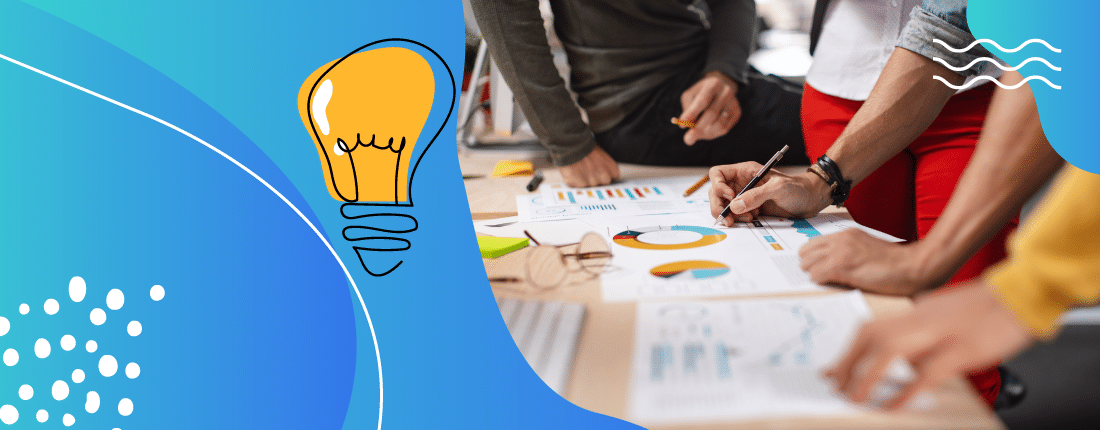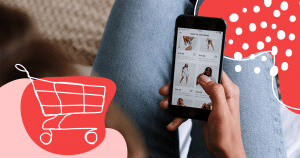For marketers, the conversion funnel is one of the best tools for understanding consumer behavior and building long-term relationships. It serves as a concise map of the customer journey and informs what kind of content your team should produce across your social channels. You can use each stage – awareness, consideration, conversion, loyalty, and advocacy – to think through the kinds of content best suited to the needs of that particular mile marker in the buyers’ journey. The goal is to continually adjust your strategy at each stage to stack the deck in favor of an eventual sale and longterm customer relationship.
The top of the funnel is wide, representing early-stage contact with a large audience. As the funnel narrows, each band represents a point of contact that’s one step closer to your goal. Prospects reach the end of the funnel when they make a purchase.
In order to initiate the customer journey, content managers and creatives must first identify the type of content that readers will find most valuable and engaging at each step in the funnel. The best place to start is with your customer personas. Think through each persona’s journey and identify their needs. What information are they looking for? What do they find entertaining? What problems do they face on a regular basis? How can you solve them?
Download this post by entering your email below

Below we walk you through the essentials of the conversion funnel so you can map out your own organization’s framework, and tie the most effective content to each stage of the funnel. We’ll also show you why the content at each stage is dependent on the type of business using two hypothetical cases – an enterprise software company (B2B) and a fashion eCommerce brand (B2C).
Step 1: Awareness
Think back to your first date. How did you dress? Where did you eat? What did you say? Chances are you carefully thought through every detail of the night. The same approach is fitting for the first step of the customer journey because it’s your one chance to grab the reader’s attention and make a positive impression.
You don’t close on the first date. At this stage, your content is focused on providing your audience with valuable information or entertaining content, not a sales pitch. Use short and catchy micro-content on social media, blog content, and evergreen material with long-tail keywords that will earn shares and help your audience solve their problems.
Experiment with content until you find the right balance for your audience. How are your customers hearing about you? Which social channels are they active on? What type of content are they looking for?
Unilever and Red Bull both excel at creating top-funnel content that raises awareness around their brands. Unilever launched the YouTube channel All Things Hair, an online space where “women could get relevant answers to their hair-care queries through high-quality video content.” The channel features popular YouTube beauty bloggers who contribute tutorials, styling tips, hair care advice, and inspiration. The channel became the most subscribed-to-hair channel in the UK and Canada, and videos receive over 1 million views. The company doesn’t use it to advertise their products, but to provide their audience with valuable information.
Similarly, Red Bull is pushing the boundaries of extreme sports, sponsoring events and showcasing the world’s most innovative athletes. Their documentary snowboarding film, The Art of Flight, explored new locations, featured new tricks, showcased the best athletes, and redefined the sport. Red Bull doesn’t get the athletes to talk about how much they love the energy drink. Instead, it gives their audience what they want – action sports cinema.
To be clear, awareness isn’t limited to upper-funnel content. Depending on the industry and customer base, content that drives awareness might be found throughout the funnel.
Using two hypothetical companies, we’ve illustrated how you might come up with an upper-funnel plan for both B2B and B2C brands:
B2B Enterprise Software:
A B2B company might want to write blog content that solves a common problem for your readers or outlines best practices. The blog is a great space to feature both in-house writers and guest posts from industry experts. Promote your blog content across Twitter and LinkedIn, and ask guest authors to promote their guest post on their social channels so you can access new networks. Remember, images are a great way to grab attention so try to incorporate images, video content, or infographics. Q&As are also a great way to leverage the power of influencers and raise awareness around your brand.
B2C Fashion eCommerce
A fashion-focused B2C company should target social media sites like Pinterest, Instagram, and Facebook. Use blog posts to spotlight the latest trends that can help buyers make smarter decisions when they go shopping. Evergreen content might include interviews with designers, tips for seasonal style, or guides to dressing for specific occasions (like prom, outdoor adventures, or a European vacation).
Step 2: Consideration
Though consideration is arguably one of the most important parts of the conversion funnel, this critical stage is often overlooked in favor of the awareness and purchase stages. However, mid-funnel content bridges the gap between the first contact and the final purchase. This is the time when prospects are sizing you up and evaluating whether they will buy your product.
This is where you need to step up and create great content that meets their needs and acts as a catalyst to conversion. it’s also a great time to introduce gated content so that you can collect data about your audience and provide personalized experiences.
Ideally, at this stage your audience is aware of your brand and are more willing to invest time in longer-form content. Consider using videos, webinars, guides, articles, quizzes, and interactive content to inform your readers while simultaneously learning more about your audience. Once you have an email address you can target them with personalized information that is more likely to pull them down the funnel.
Here at Rock Content, we like to offer webinars and gated ebooks to help our customers learn how to do content marketing effectively while also learning more about them and what kind of content they’re looking for so we can better cater to their needs. Our ebooks often use our own data science tech and link to our blog posts but the focus remains on providing valuable information, not selling.
B2B Enterprise Software:
If you were a B2B Enterprise Software company, you might consider hosting a webinar series about the five critical technology opportunities businesses can capitalize on this year. You could build interest and attendance by promoting the webinars via e-newsletters and social media. you could also set up a gated registration page to collect information, connect with prospects, and send follow-up reminders to maximize attendance.
B2C Fashion eCommerce:
A fashion brand might publish a summer fashion ebook showcasing the season’s trends, establishing your company as a thought leader. Make the content accessible only through a registration site that collects email and other demographic information that can be used for future follow-up and a more personalized experience.
Step 3: Conversion
At this stage of the conversion funnel it’s time to showcase the power of your product. You might not like to brag, but you need to show your audience why you’re the right choice. Highlight the value of your brand through content like case studies, live chats, and product guides. Ideally, you should incorporate quotes or endorsements from well-known brands and figures, and positive reviews from customers to build trust.
TOMS shoes does a great job of pulling customers down the funnel because their product helps their customers feel good about making a purchase. For every pair of TOMS shoes purchased, the company donates a pair of shoes to a person in need. Their program has expanded to include medical services, eyeglasses, water, safe birth kits, and anti-bullying programs. Their blog is a collection of stories that highlights the personal stories of people from around the world who have benefited from TOMS shoes. They also use social media to showcase the people and programs that the company has created. This helps the customer feel good about purchasing the product. Their blog doesn’t overtly sell shoes, but it does help the reader understand why they might be the right choice.
B2B Enterprise Software:
Conduct interviews with some of your best customers and turn them into a case study that showcases the pain points customers faced before doing business with you. Highlight how they have succeeded as a result of the relationship with your company. The guide should outline the problem, how your product solved it, and any unique case studies for that particular customer.
B2C Fashion eCommerce:
Create an infographic that outlines how your brand solves a problem. Do you have better prices? Do you use organic materials? Are you sweatshop-free? Are proceeds going to a particular cause? How can you help your audience feel good about purchasing your clothing over another brand? Get personal and put a face to the clothing. Expand your “About Us” page to include photos and biographies of each designer and link to the e-commerce page where shoppers can purchase their creations.
Step 4: Loyalty
Congratulations! Now that you’ve made a sale you have the opportunity to create a brand advocate! This means you’ve got to keep the wow factor coming by providing a solid product, great customer service, and awesome content that keeps your business top of mind.
Keep in touch with your customers after the purchase through social media and email newsletters. use these mediums to show your followers some love by sharing their content on your feed or asking for their input. This can help you create advocates, one of the most powerful ways to find future customers and strengthen relationships with people lingering in the “consideration” phase.
Building a community, creating valuable content, and encouraging engagement will take you farther than any gimmick strictly intending to squeeze one more sale out of your audience.
B2B Enterprise Software:
Follow up after a purchase with a personal thank you via email. This message should contain all of your pertinent social media channels with a call to action asking them to stay connected. You can also send out a weekly e-newsletter that gives them exclusive access to mid-funnel content, notifications about new products, details about upcoming events, or relevant blog posts. You might also consider creating a forum where customers can give feedback. Make sure that you answer comments and use the feedback to improve and optimize your product and buyer’s journey.
B2C Fashion eCommerce:
Send a thank you coupon with a discount on the next purchase as part of their email receipt, and encourage them to follow you on social media. Use social media to showcase the content created by your followers on Facebook, Twitter, Instagram, or Snapchat. Retweet content from your followers and organize a contest that asks for UGC, allowing your fans to upload photos of themselves wearing clothing for a chance to win a free product. You can also use this space to collect feedback from your advocates and get input on future products. What color palette do you prefer? What styles are you looking for? What’s important to your customer base?
At the end of the day, you have to show that it’s about more than just the bottom line. The goal here is to be genuine and sincere while positioning your brand as a clear leader based not on your word (or great content), but on the strength of the products, services and customer service you provide. This will build trust and empower your loyal customers to become spokespeople for your brand and its mission.
A customer’s journey is never clear cut, but the conversion funnel serves as a basic content framework that can help you meet their needs and build a strong relationship along the way.
2024 State of Marketing Report
Your golden ticket to crush your goals with data-driven insights!
2024 State of Marketing Report
Your golden ticket to crush your goals with data-driven insights!

![[Rock NA] State of Marketing Reports 2024 – Comkt Hubspot State of Marketing Report 2024](https://rockcontent.com/wp-content/uploads/2022/07/Banner-Fino-Rock-Convert-2500-%C3%97-500-px-19.png)







